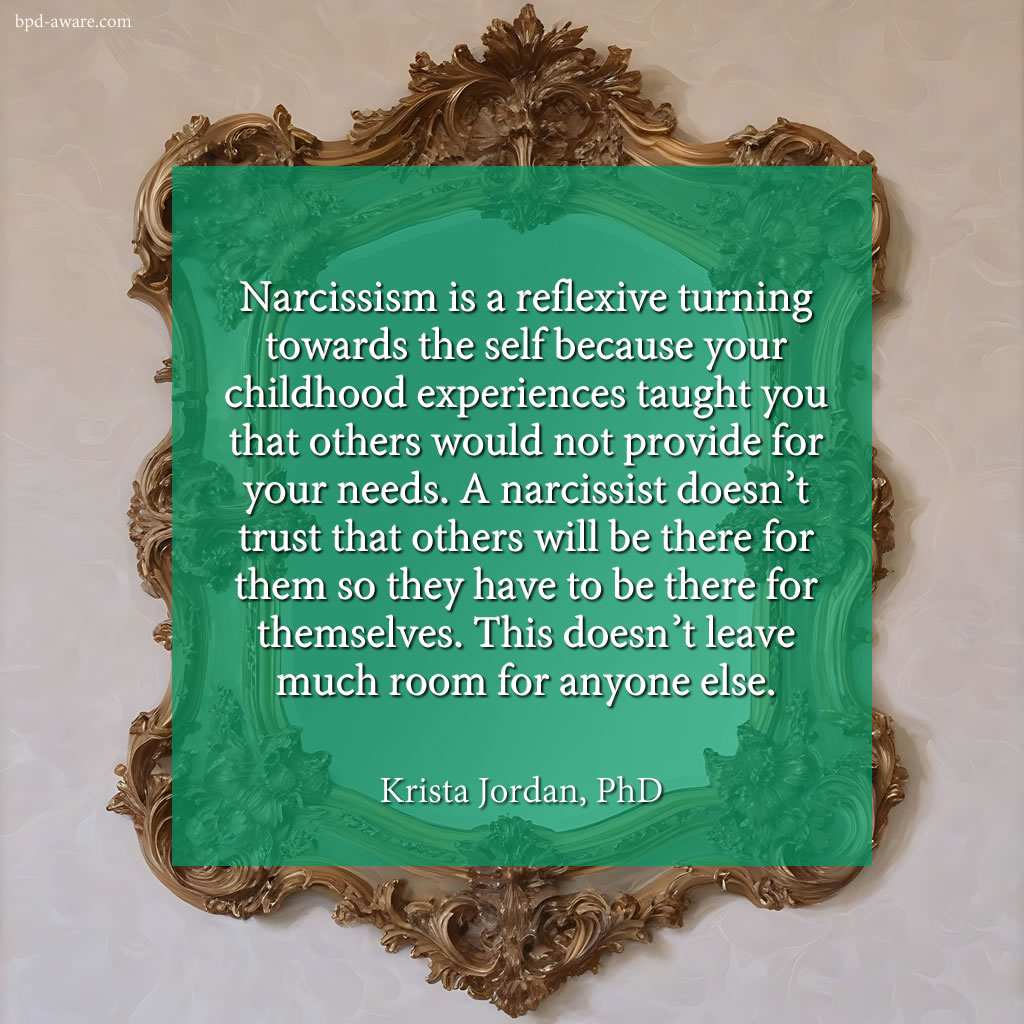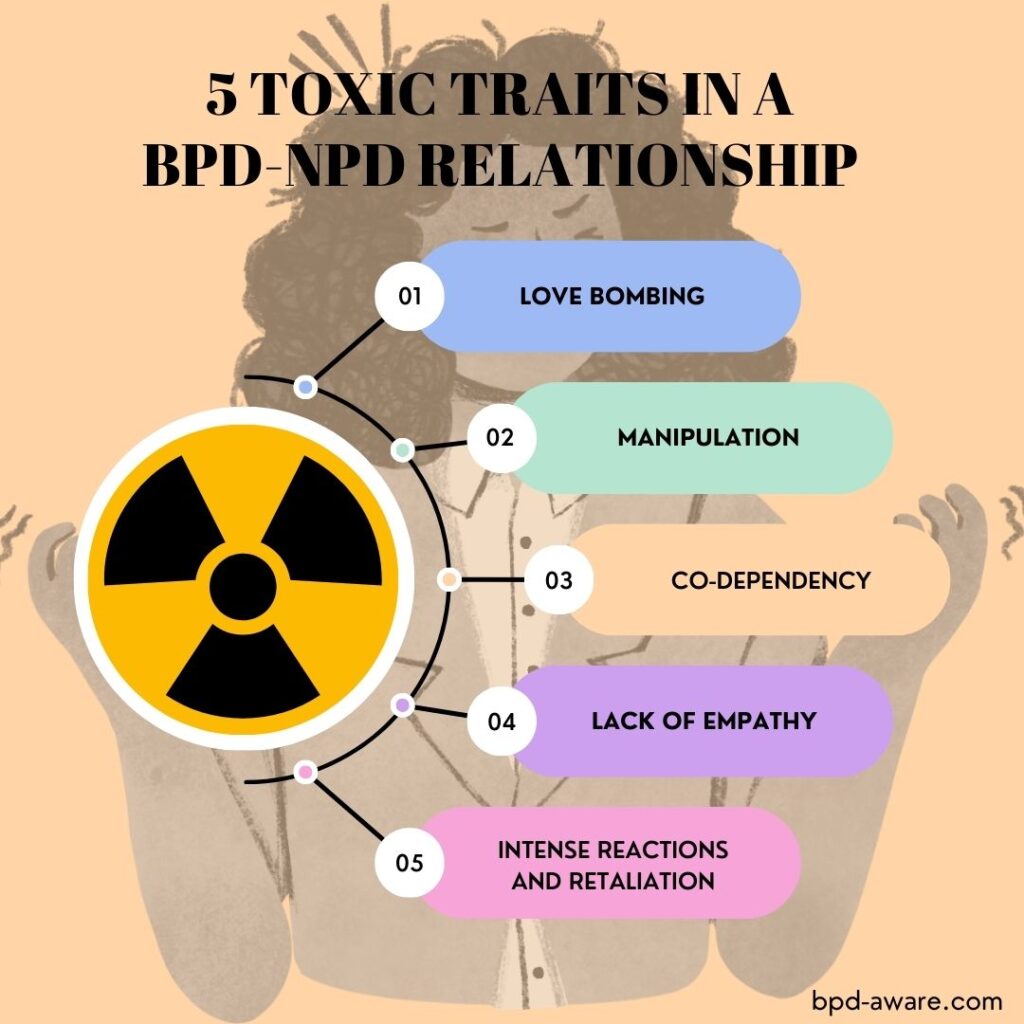Borderline Personality Disorder (BPD) and Narcissistic Personality Disorder (NPD) are part of the Cluster B type of personality disorders. Cluster B is a group of mental health conditions characterized by dramatic, overly emotional, or unpredictable thinking or behavior. They are part of the DSM-5 (Diagnostic and Statistical Manual of Mental Disorders, 5th Edition) along with Antisocial Personality Disorder, and Histrionic Personality Disorder.
Individuals with BPD often experience intense emotions, fear of abandonment, and instability in relationships. They might exhibit extreme reactions to perceived rejections or separations and have a shifting sense of self. This can lead to a volatile life with lots of short-term relationships and having to move from job to job.
NPD is characterized by a need for excessive admiration, a lack of empathy for others, and a strong sense of self-importance. People with Narcissistic Personality Disorder often exaggerate their achievements, fantasize about power and success, and may exploit others for their own gain. Because of the nature of their disorder, people with NPD rarely seek treatment as they don’t believe anything is wrong with them.
Someone can have both BPD and NPD simultaneously. This occurrence is known as comorbidity, which refers to the presence of more than one disorder or illness in the same person. One study found that roughly 13% of people who’d been diagnosed with BPD also met the diagnostic criteria to be diagnosed with NPD.
However, the co-occurrence of BPD and NPD can be extremely difficult to diagnose and treat because the manifestations associated with each disorder can interact and exacerbate each other. For instance, the impulsivity common in BPD might be compounded by the lack of empathy often found in NPD, leading to more pronounced difficulties in relationships and self-regulation.
Common Traits of BPD and NPD
- Emotional Instability: Both may experience intense and fluctuating emotions, though the trigger and expression of these emotions can differ.
- Impulsivity: Individuals with either disorder may display impulsive behaviors, though the nature and consequences of these behaviors can vary.
- Challenges in Relationships: Both disorders often involve problematic relationship patterns, including difficulties in maintaining stable and healthy relationships.
- Self-Image Issues: People with BPD often have a distorted and unstable self-image, which can also be a feature of NPD, where there’s an inflated sense of self-importance.
- Fear of Abandonment: This is a core feature of BPD and can sometimes be seen in NPD in the form of needing constant admiration and attention.
- Manipulative Behaviors: Both may exhibit manipulative behaviors, although the motivations and methods can differ significantly.
Differences Between BPD and NPD
- Empathy: People with NPD typically have a significant lack of empathy, being unable to recognize or understand the feelings and needs of others. In contrast, individuals with BPD may have varying levels of empathy, sometimes showing heightened sensitivity to the emotions of others.
- Self-Image: NPD is characterized by grandiosity and an inflated sense of self-worth, whereas BPD is more associated with an unstable self-image, often fluctuating between extremes.
- Fear of Abandonment: While this is a hallmark of BPD, it’s less central in NPD. For those with BPD, abandonment fears can dominate their thoughts and actions.
- Relationships with Others: In BPD, relationships are often intense and highly variable, swinging from idealization to devaluation. In NPD, relationships are primarily used to bolster self-esteem and can be characterized by a lack of genuine connection and exploitation.
- Reaction to Criticism: Individuals with NPD are often very sensitive to criticism and may react with anger or contempt. In contrast, those with BPD might react intensely to criticism due to fears of abandonment or rejection, but their reactions can be more self-destructive than outwardly aggressive.
- Identity Issues: While both may struggle with self-identity, in BPD, this struggle is more pronounced and central, with individuals often experiencing a chronic feeling of emptiness and a poorly defined sense of self.

Treatment Approaches
The treatment approaches for NPD and BPD can also differ. BPD often responds well to therapies like Dialectical Behavior Therapy (DBT), which focuses on building skills to manage emotions, improve relationships, and reduce self-destructive behaviors. NPD, on the other hand, can be more challenging to treat, partly due to resistance to acknowledging the disorder or engaging in therapy. Treatment may focus on issues like empathy development, emotional regulation, and improving interpersonal relationships.
Treatment for someone with both BPD and NPD would need to be carefully tailored to address the symptoms and underlying issues of both disorders. This often involves a combination of psychotherapy approaches, possibly supplemented by medication to manage specific symptoms like mood swings or anxiety. It’s also crucial for the treatment plan to be adaptable, as the needs and responses of someone with comorbid personality disorders can change over time.
Relationships Between Someone With BPD and Someone With NPD
A romantic relationship (or close friendship) between someone with Borderline Personality Disorder and a person with Narcissistic Personality Disorder can quickly become toxic due to the traits and needs of both individuals.
People with NPD tend to “love bomb” – this is where a person showers someone with excessive affection, attention, and admiration in a very short period. Love bombing works particularly well on people with BPD as they often have low self-esteem and a poor image of themselves, so being given so much attention feels intoxicating. In turn the person with BPD latches on to the individual NPD and makes them their “Favorite Person” – showering the narcissist with the love and affection they crave.
There are a several problems that can quickly develop in a BPD-NPD relationship. Exploring specific examples can provide a clearer understanding of the complex dynamics and problems that might arise in a relationship between someone with BPD and someone with NPD. These examples are generalized and may not apply to every individual with these disorders, but they illustrate common patterns observed in such relationships.
Example 1: Emotional Turmoil and Manipulation
- Situation: The individual with BPD experiences intense fear of abandonment, leading them to seek constant reassurance and attention from their partner. The partner with NPD, driven by a need for admiration and control, may initially provide this attention but soon starts to manipulate these needs to maintain control and feed their ego.
- Outcome: This dynamic can lead to a cycle of emotional highs and lows, where the person with BPD feels temporarily reassured but then increasingly anxious and insecure as the narcissistic partner withdraws attention or uses it as a tool for manipulation.
Example 2: Conflict and Blame
- Situation: During conflicts, the individual with NPD might refuse to acknowledge their role in the problems, projecting blame onto the partner with BPD. The BPD partner, sensitive to criticism and rejection, may react intensely, further escalating the conflict.
- Outcome: This can result in a pattern where conflicts are never constructively resolved, leading to a buildup of resentment and further destabilization of the relationship.
Example 3: Lack of Empathy and Support
- Situation: The person with BPD may go through periods of intense emotional distress and need emotional support. However, the partner with NPD, having limited empathy, might not provide the needed support, dismissing the BPD partner’s feelings as overreactions or inconveniences.
- Outcome: This lack of empathy and support can deepen the emotional distress of the individual with BPD, potentially leading to a worsening of their symptoms.
Example 4: Co-dependency and Erosion of Self-Esteem
- Situation: The BPD individual’s fear of abandonment and the NPD individual’s need for admiration can create a co-dependent relationship. The BPD partner may tolerate abusive or manipulative behavior out of fear of being alone, while the NPD partner relies on the BPD partner for constant validation.
- Outcome: This co-dependency can erode the self-esteem and identity of the BPD partner, while the NPD partner becomes increasingly controlling and dismissive.
Example 5: Intense Reactions and Retaliation
- Situation: In response to perceived slights or abandonment, the individual with BPD may have an intense emotional reaction, which can be overwhelming for the partner with NPD, who may retaliate with anger or emotional withdrawal.
- Outcome: This pattern can lead to a toxic cycle of emotional reactions and retaliations, exacerbating the instability and unpredictability of the relationship.
This is not to say that a healthy relationship between someone with BPD and a partner with NPD isn’t possible. However, it would take both parties being in individual therapy, couples therapy, and having strong support networks for it to have a chance.

Final Thoughts
In conclusion, BPD and NPD are complex mental health conditions that, despite sharing certain traits such as impulsivity and difficulties with relationships, are distinct in their symptoms and impact on individuals’ lives. While BPD is often characterized by emotional instability, fear of abandonment, and an unclear self-image, NPD is defined by an overly inflated sense of self-importance, a deep need to be admired, and a lack of empathy for others. Understanding the different complexities of these disorders is crucial, not only for mental health professionals in diagnosis and treatment but also for increasing public awareness and reducing the stigma associated with these conditions.
We’ve learned that it’s entirely possible to have BPD and NPD at the same time. While treatment can be tricky for these comorbid conditions, it’s not impossible and is worth pursuing.
Likewise, relationships between people with BPD and NPD can be very difficult but not impossible. In relationships where both parties are committed to therapy and personal growth, healthier dynamics are possible. However, the combination of BPD and NPD can create a particularly challenging dynamic that often requires professional intervention and support.
Sources, Resources, and Further Reading:
- Borderline Personality Disorder and Narcissism: https://www.verywellmind.com/narcissistic-personality-disorder-425426
- The Patterns Of Narcissists In Romantic Relationships: https://narcissisms.com/the-patterns-of-a-narcissist-in-a-romantic-relationship/
- Comorbidity borderline-narcissistic personality disorder: https://pmc.ncbi.nlm.nih.gov/articles/PMC10434708/
- BPD vs. NPD: Signs of an Abusive Partner: https://psychcentral.com/disorders/the-differences-between-abusers-with-narcissistic-personality-disorder-vs-borderline-personality-disorder
















